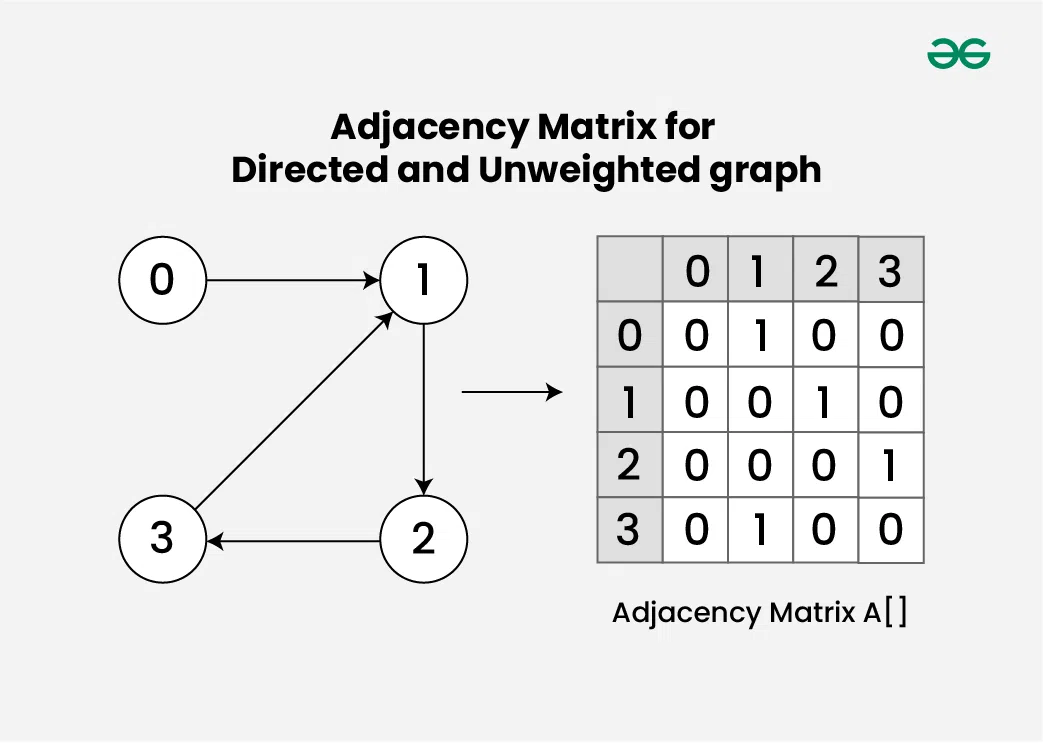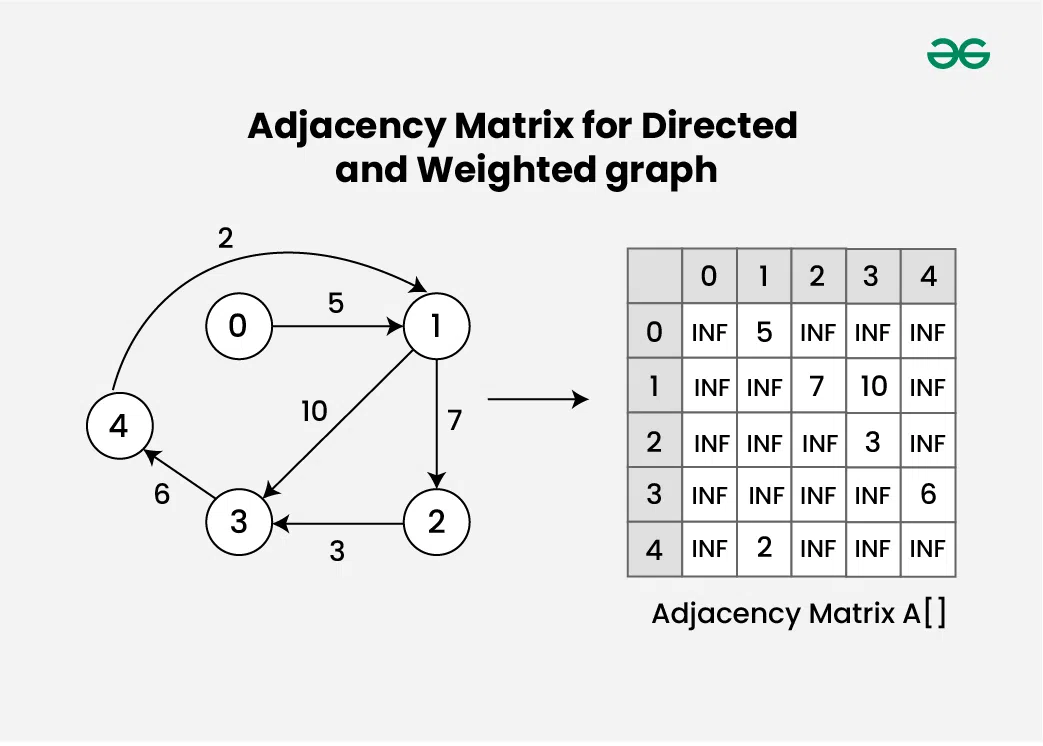Adjacency Matrix of a Directed Graph is a square matrix that represents the graph in a matrix form. In a directed graph, the edges have a direction associated with them, meaning the adjacency matrix will not necessarily be symmetric.
In a directed graph, the edges have a direction associated with them, meaning the adjacency matrix will not necessarily be symmetric. The adjacency matrix A of a directed graph is defined as follows:
What is Adjacency matrix of Directed graph?
For a graph with N vertices, the adjacency matrix A is an N X N matrix where:
- A[i][j] is 1 if there is a directed edge from vertex i to vertex j.
- A[i][j] is 0 otherwise.
Adjacency Matrix for Directed and Unweighted graph:
Consider an Directed and Unweighted graph G with 4 vertices and 4 edges. For the graph G, the adjacency matrix would look like:

Here’s how to interpret the matrix:
- A[0][1] = 1, there is an edge between vertex 0 and vertex 1.
- A[1][2] = 1, there is an edge between vertex 1 and vertex 2.
- A[2][3] = 1, there is an edge between vertex 2 and vertex 3.
- A[3][1] = 1, there is an edge between vertex 3 and vertex 1.
- A[i][i] = 0, as there are no self loops on the graph.
- All other entries with a value of 0 indicate no edge between the corresponding vertices.
Adjacency Matrix for Directed and Weighted graph:
Consider an Directed and Weighted graph G with 5 vertices and 6 edges. For the graph G, the adjacency matrix would look like:

Here’s how to interpret the matrix:
- A[0][1] = 1, there is an edge between vertex 0 and vertex 1.
- A[1][2] = 1, there is an edge between vertex 1 and vertex 2.
- A[2][3] = 1, there is an edge between vertex 2 and vertex 3.
- A[3][1] = 1, there is an edge between vertex 3 and vertex 1.
- A[i][i] = 0, as there are no self loops on the graph.
- All other entries with a value of 0 indicate no edge between the corresponding vertices.
Properties of Adjacency Matrix of Directed Graph:
- Diagonal Entries: The diagonal entries Aii are usually set to 0, assuming the graph has no self-loops.
- Out-degree and In-degree: The number of 1's in a row i (out-degree) indicates the number of outgoing edges from vertex i, while the number of 1's in a column j (in-degree) indicates the number of incoming edges to vertex j.
Implementation of Adjacency Matrix of Directed Graph:
Below is the implementation of Adjacency Matrix of Directed Graph in different languages:
#include <algorithm>
#include <iostream>
#include <unordered_map>
#include <vector>
std::vector<std::vector<int> > create_adjacency_matrix(
std::unordered_map<std::string,
std::vector<std::string> >
graph)
{
std::vector<std::string> vertices;
// Get sorted list of vertices
for (const auto& pair : graph) {
vertices.push_back(pair.first);
}
std::sort(vertices.begin(), vertices.end());
int num_vertices = vertices.size();
// Initialize the adjacency matrix with zeros
std::vector<std::vector<int> > adj_matrix(
num_vertices, std::vector<int>(num_vertices, 0));
// Fill the adjacency matrix based on the edges in the
// graph
for (int i = 0; i < num_vertices; ++i) {
for (const auto& neighbor : graph[vertices[i]]) {
int j = std::distance(
vertices.begin(),
std::find(vertices.begin(), vertices.end(),
neighbor));
adj_matrix[i][j] = 1;
}
}
return adj_matrix;
}
int main()
{
// Example graph represented as a dictionary
// The keys are the vertices and the values are lists of
// neighboring vertices
std::unordered_map<std::string,
std::vector<std::string> >
graph = { { "1", { "2" } },
{ "2", { "3" } },
{ "3", { "4" } },
{ "4", { "1" } } };
// Create the adjacency matrix
std::vector<std::vector<int> > adj_matrix
= create_adjacency_matrix(graph);
// Print the adjacency matrix
for (const auto& row : adj_matrix) {
for (int value : row) {
std::cout << value << " ";
}
std::cout << std::endl;
}
return 0;
}
import java.util.ArrayList;
import java.util.Collections;
import java.util.HashMap;
import java.util.List;
public class AdjacencyMatrix {
// Function to create an adjacency matrix from an
// adjacency list
public static int[][] createAdjacencyMatrix(
HashMap<String, List<String> > graph)
{
// Get the list of vertices sorted in ascending
// order
List<String> vertices
= new ArrayList<>(graph.keySet());
Collections.sort(vertices);
// Get the number of vertices in the graph
int numVertices = vertices.size();
// Initialize the adjacency matrix with zeros
int[][] adjMatrix
= new int[numVertices][numVertices];
// Fill the adjacency matrix based on the edges in
// the graph
for (int i = 0; i < numVertices; i++) {
// Get the neighbors of the current vertex
List<String> neighbors
= graph.get(vertices.get(i));
for (String neighbor : neighbors) {
// Find the index of the neighbor in the
// sorted vertices list
int j = vertices.indexOf(neighbor);
// Set the corresponding entry in the
// adjacency matrix to 1
adjMatrix[i][j] = 1;
}
}
return adjMatrix;
}
public static void main(String[] args)
{
// Example graph represented as an adjacency list
// (unordered map)
HashMap<String, List<String> > graph
= new HashMap<>();
graph.put("1", List.of("2"));
graph.put("2", List.of("3"));
graph.put("3", List.of("4"));
graph.put("4", List.of("1"));
// Create the adjacency matrix from the graph
int[][] adjMatrix = createAdjacencyMatrix(graph);
// Print the adjacency matrix
for (int[] row : adjMatrix) {
for (int value : row) {
System.out.print(value + " ");
}
System.out.println();
}
}
}
// This code is contributed by shivamgupta0987654321
def create_adjacency_matrix(graph):
"""
Create an adjacency matrix for a directed graph.
Parameters:
graph (dict): A dictionary representing the directed graph.
Returns:
list: The adjacency matrix of the graph.
"""
vertices = sorted(graph.keys()) # Get sorted list of vertices
num_vertices = len(vertices)
# Initialize the adjacency matrix with zeros
adj_matrix = [[0] * num_vertices for _ in range(num_vertices)]
# Fill the adjacency matrix based on the edges in the graph
for i, vertex in enumerate(vertices):
for neighbor in graph[vertex]:
j = vertices.index(neighbor)
adj_matrix[i][j] = 1
return adj_matrix
# Example graph represented as a dictionary
# The keys are the vertices and the values are lists of neighboring vertices
graph = {
'1': ['2'],
'2': ['3'],
'3': ['4'],
'4': ['1']
}
# Create the adjacency matrix
adj_matrix = create_adjacency_matrix(graph)
# Print the adjacency matrix
for row in adj_matrix:
print(row)
function createAdjacencyMatrix(graph) {
const vertices = Object.keys(graph).sort();
const numVertices = vertices.length;
// Initialize the adjacency matrix with zeros
const adjMatrix = Array.from(Array(numVertices), () => Array(numVertices).fill(0));
// Fill the adjacency matrix based on the edges in the graph
for (let i = 0; i < numVertices; ++i) {
for (const neighbor of graph[vertices[i]]) {
const j = vertices.indexOf(neighbor);
adjMatrix[i][j] = 1;
}
}
return adjMatrix;
}
// Example graph represented as a dictionary
// The keys are the vertices and the values are lists of neighboring vertices
const graph = {
"1": ["2"],
"2": ["3"],
"3": ["4"],
"4": ["1"]
};
// Create the adjacency matrix
const adjMatrix = createAdjacencyMatrix(graph);
// Print the adjacency matrix
for (const row of adjMatrix) {
console.log(row.join(' '));
}
Output
[0, 1, 0, 0] [0, 0, 1, 0] [0, 0, 0, 1] [1, 0, 0, 0]